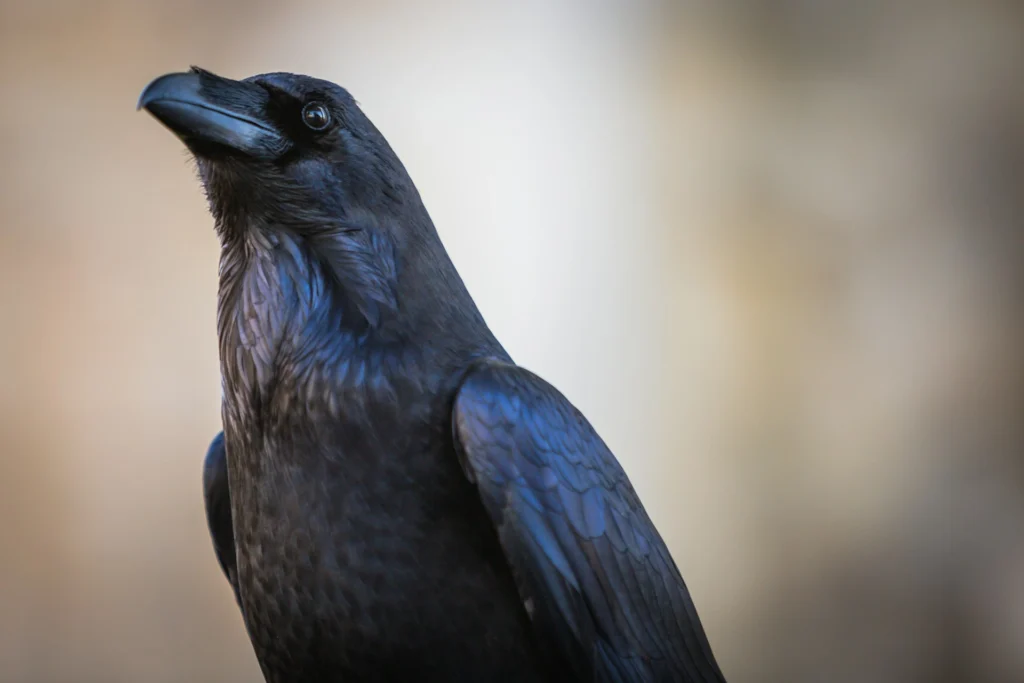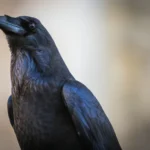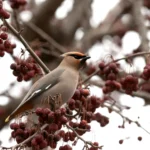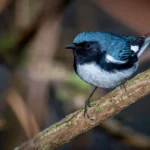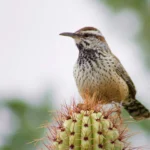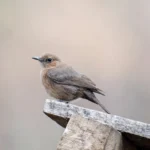Arizona’s vast deserts, rugged mountains, and riparian landscapes provide habitats for some of the most striking birds in North America. Among them, Large Black Birds in Arizona stand out with their bold presence, dark plumage, and commanding flight patterns. From intelligent ravens and crows to soaring vultures and stealthy hawks, these birds play an essential role in maintaining balance within Arizona’s ecosystems.
Spotting a large black bird in the desert sky or perched on a cactus is a memorable experience for birdwatchers and casual observers alike. Many of these species are not only visually impressive but also deeply symbolic, often associated with mystery, transformation, or survival in challenging environments. In this guide, we’ll explore the different types of large black birds found in Arizona, looking at their appearance, behavior, and importance in the natural world.
Table of Contents
Common Raven
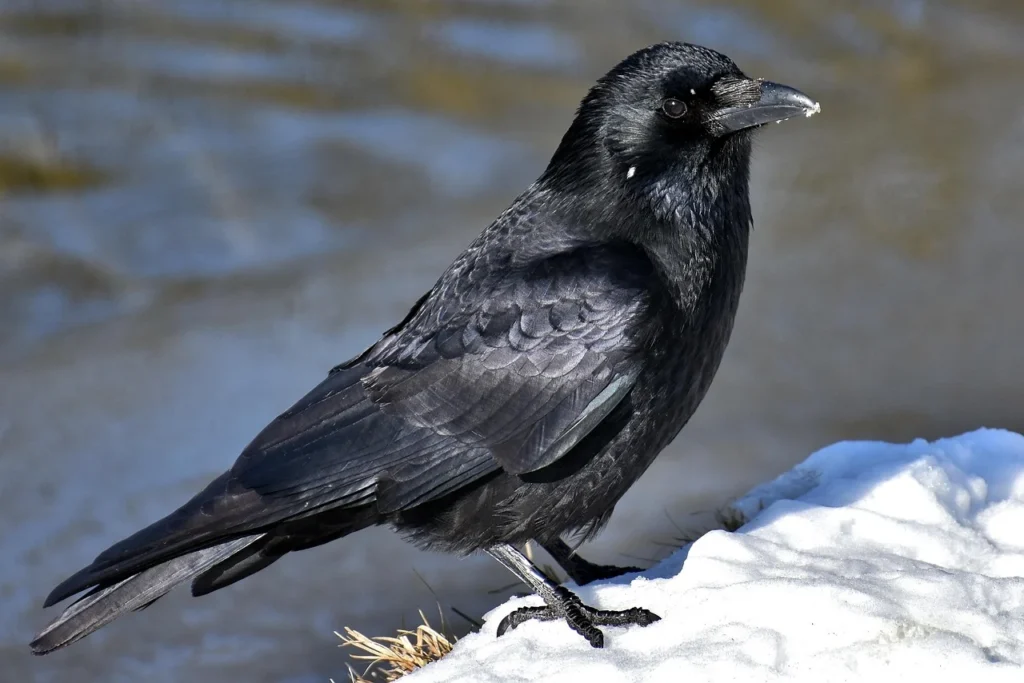
Appearance
The Common Raven is one of the largest black birds in Arizona, reaching up to 27 inches in length with a wingspan of over four feet. Its thick, shaggy throat feathers, wedge-shaped tail, and massive curved bill set it apart from crows. When sunlight hits its plumage, a subtle blue or purple sheen often appears.
Habitat
Ravens are highly adaptable and can be found in nearly every corner of Arizona, from high desert mesas and forests to urban areas. They often perch on cliffs, telephone poles, and even city buildings, always scanning their surroundings.
Diet
Opportunistic feeders, ravens eat almost anything—carrion, insects, seeds, fruits, small animals, and human food scraps. Their intelligence allows them to open containers, scavenge from trash, and even follow predators to steal leftovers.
Behavior
Known for their intelligence, ravens are problem-solvers and tool users. They display aerial acrobatics, sometimes flipping mid-air just for fun. Their deep, croaking call is unmistakable and often echoes across canyons.
Nesting
Ravens typically nest on cliffs, tall trees, or manmade structures. They build large stick nests, often reusing the same site for years. Both parents share in raising the young.
Conservation
The Common Raven is widespread and not considered at risk. In fact, its population has expanded in Arizona thanks to its ability to adapt to human-altered environments.
Also Read : 13 Birds That Look Like Cardinals
American Crow
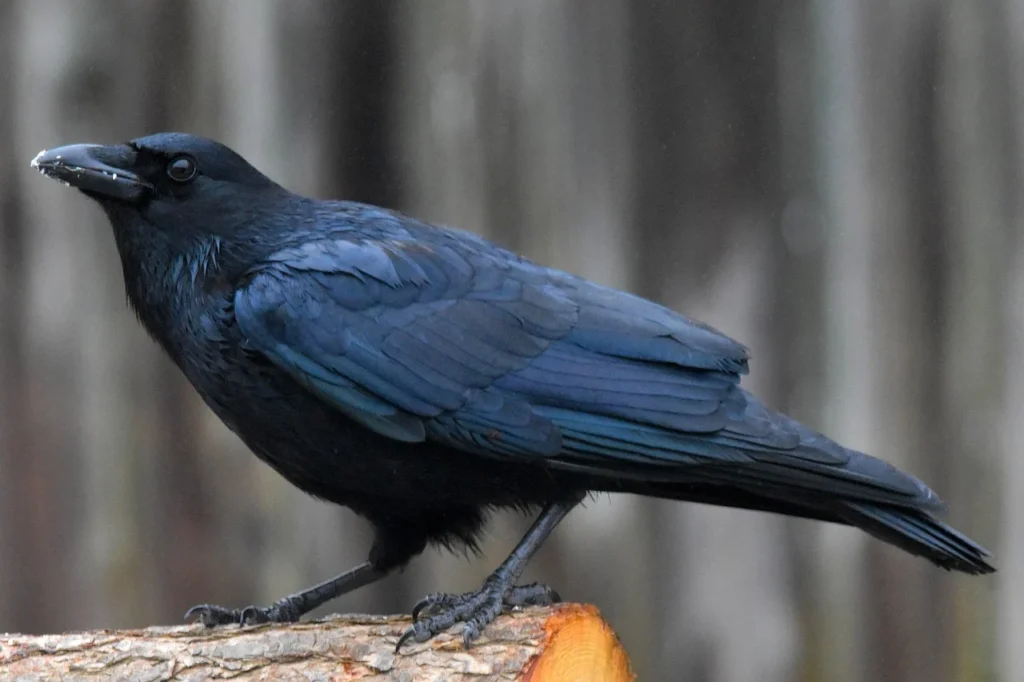
Appearance
The American Crow is slightly smaller than the raven, averaging about 17 inches long with a wingspan of around three feet. Its feathers are jet black with a faint gloss, and it has a slimmer bill and a more fan-shaped tail compared to the raven.
Habitat
In Arizona, crows are more common in agricultural areas, suburbs, and towns rather than deep deserts. They thrive where people are present, often gathering in fields, parks, and near water sources.
Diet
American Crows are omnivores, feeding on grains, insects, small animals, fruits, carrion, and human leftovers. Their adaptability makes them successful in both rural and urban environments.
Behavior
Crows are highly social, often seen in groups called “murders.” They are known for their intelligence, using tools, solving puzzles, and remembering human faces. Their cawing calls are loud and sharp, helping them communicate warnings and territory claims.
Nesting
They usually nest in tall trees, building sturdy stick nests lined with soft materials. Both parents share the responsibility of incubating eggs and raising the chicks.
Conservation
The American Crow is widespread and thriving across North America. In Arizona, their population remains stable, supported by their adaptability to human presence and varied habitats.
Also Read : Birds That Look Like Blue Jays: 9 Striking Look-Alikes for Curious Birders
Chihuahuan Raven
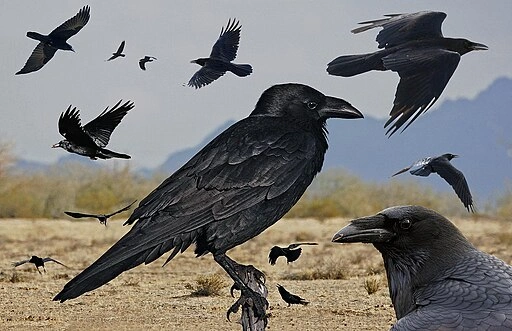
Appearance
The Chihuahuan Raven looks very similar to the American Crow but is slightly smaller than the Common Raven. It has a long, straight bill, a wedge-shaped tail, and glossy black feathers with a purplish sheen. Its pale, whitish feather bases—visible when the wind ruffles its plumage—are a key identification mark.
Habitat
This species is closely tied to the desert grasslands and open scrub of southern Arizona. Unlike crows and ravens that often frequent cities, Chihuahuan Ravens are more common in rural areas, often perching on fence posts, utility poles, or low trees.
Diet
Their diet is varied, including insects, grains, carrion, and small animals. They often follow farming activities, scavenging freshly plowed fields or gathering where livestock are present.
Behavior
Chihuahuan Ravens are social birds, usually seen in small flocks. They are skilled flyers, sometimes gliding over grasslands in graceful arcs. Their calls are higher-pitched and more nasal than the deep croak of the Common Raven.
Nesting
They nest in mesquite trees, utility poles, or other tall structures. Their stick nests are often reused, and pairs are known to return to the same sites year after year.
Conservation
Populations are stable, though their range is limited compared to the widespread Common Raven. In Arizona, they are primarily found in the southeastern and southern regions of the state.
Also Read : 15 Birds Found in Arizona Desert
Turkey Vulture
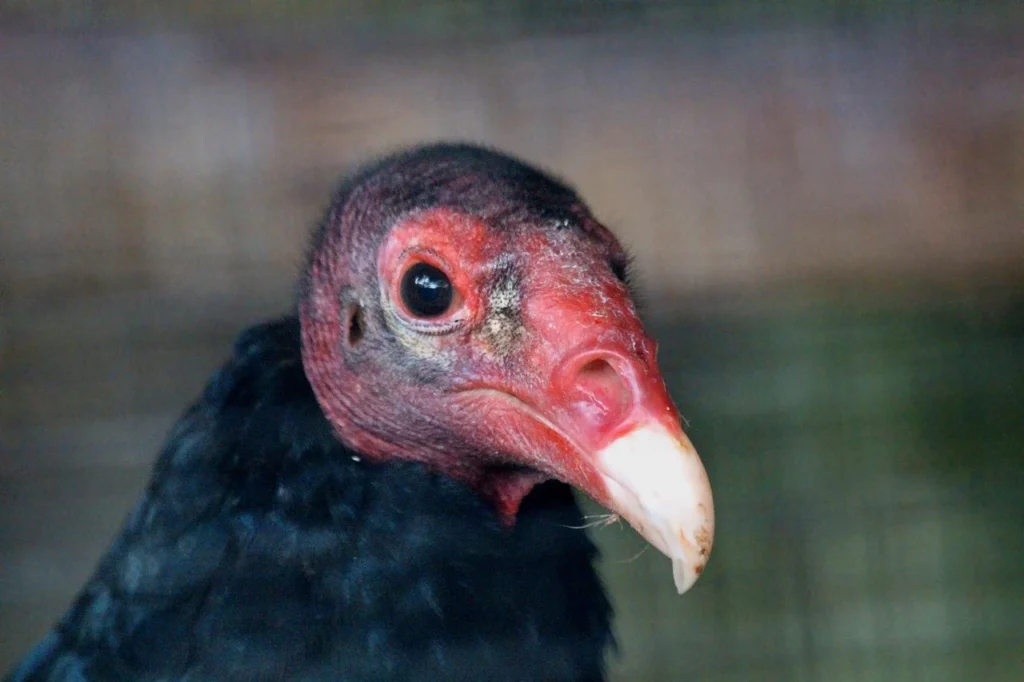
Appearance
The Turkey Vulture is one of the largest soaring birds in Arizona, with a wingspan reaching up to six feet. Its plumage is mostly dark brownish-black, with silvery flight feathers that shine in the sun. Unlike crows and ravens, it has a bare, red head, which prevents bacteria from clinging while feeding on carrion.
Habitat
These vultures are found across Arizona, from deserts and canyons to forests and open plains. They prefer areas with wide open skies for soaring and rocky cliffs or dense woods for roosting. During summer, they are a common sight riding thermal air currents overhead.
Diet
As scavengers, Turkey Vultures feed almost exclusively on carrion. Their strong sense of smell, unusual among birds, helps them detect dead animals even under thick vegetation.
Behavior
They are graceful fliers, holding their wings in a shallow “V” while gliding effortlessly. Despite their ominous reputation, Turkey Vultures are gentle birds that rarely harm living creatures. They often gather in communal roosts, sometimes numbering in the hundreds.
Nesting
Turkey Vultures do not build traditional nests. Instead, they lay eggs directly on bare ground, in caves, hollow trees, or sheltered rock crevices. The chicks are fed regurgitated food until they fledge.
Conservation
The species is widespread and thriving. In Arizona, their population benefits from the abundance of carrion and open landscapes, making them an essential part of the ecosystem’s cleanup crew.
Also Read: Orange Birds in Arizona: A Colorful Birdwatcher’s Guide
Great-tailed Grackle
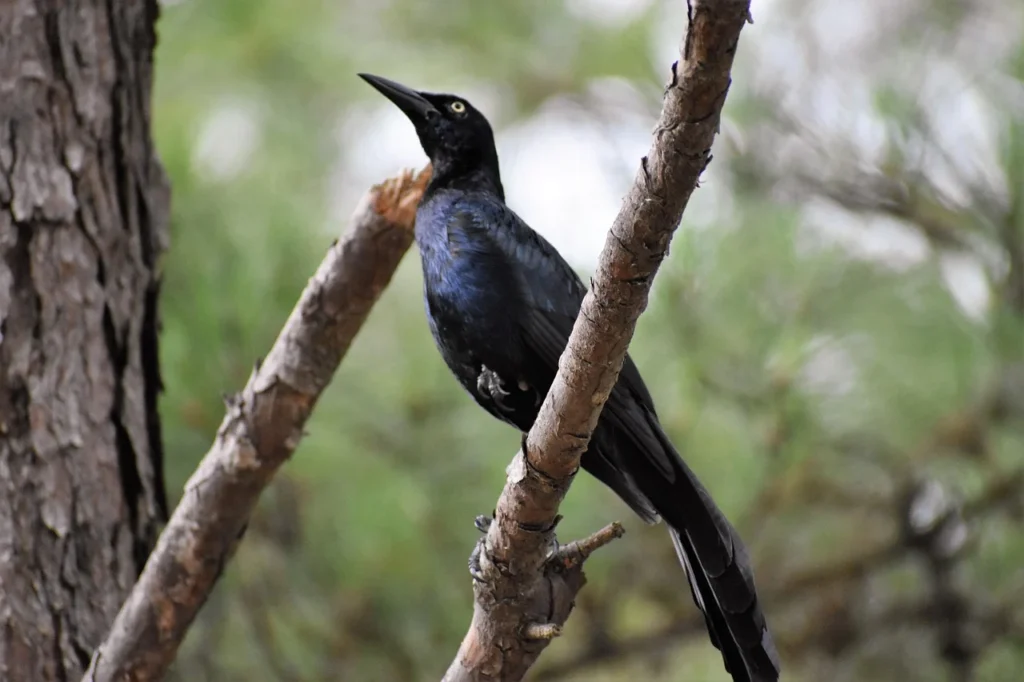
Appearance
The Great-tailed Grackle is a sleek, medium-to-large blackbird with males reaching up to 18 inches in length. Males are glossy black with striking iridescent hues of purple and blue that shimmer in sunlight. Their long, V-shaped tails are their most distinctive feature. Females are smaller and brown with lighter underparts.
Habitat
These adaptable birds are common in Arizona’s urban areas, agricultural fields, and wetlands. They often gather around shopping centers, golf courses, and city parks, thriving in both human-dominated and natural landscapes.
Diet
Grackles are opportunistic feeders, eating insects, grains, fruits, small animals, and discarded human food. They are often seen scavenging in parking lots or foraging along waterways.
Behavior
Highly social and noisy, Great-tailed Grackles form large flocks that fill the air with whistles, clicks, and sharp calls. Males often display by spreading their tails and puffing up to impress females or ward off rivals.
Nesting
They nest in colonies, often in tall trees or reeds near water. Nests are cup-shaped and made of grasses, twigs, and plant fibers. Females handle most of the incubation and chick-rearing duties.
Conservation
The population of Great-tailed Grackles is growing in Arizona as they adapt easily to human-altered environments. Their bold nature makes them one of the most visible and easily recognized black birds in the state.
Double-crested Cormorant
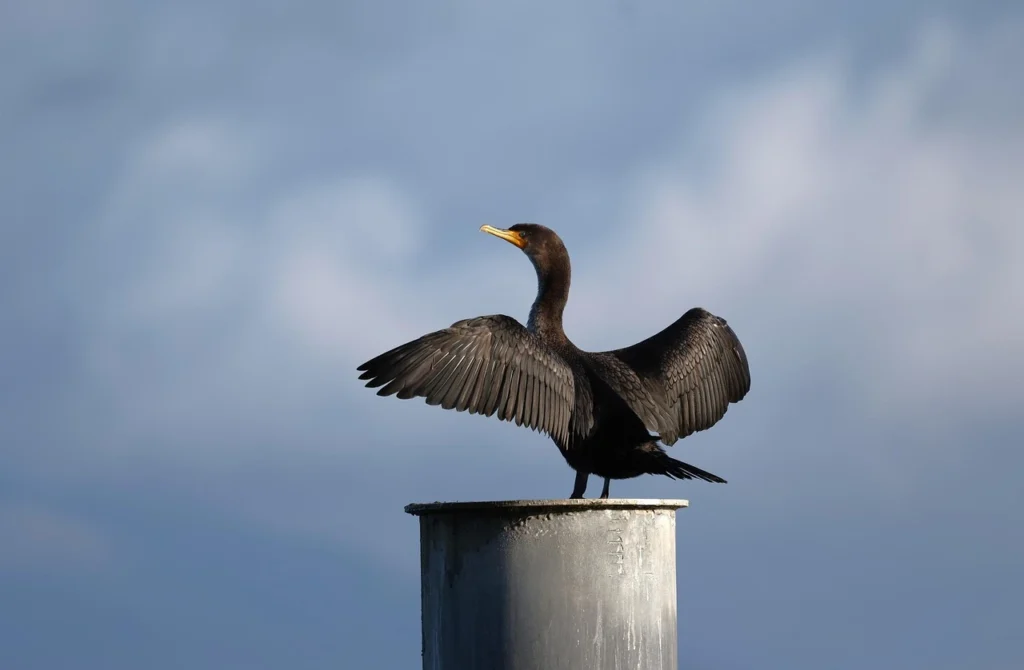
Appearance
The Double-crested Cormorant is a large waterbird, about 30–35 inches long, with an impressive wingspan of up to five feet. Its plumage is dark brownish-black, and during breeding season, adults develop small tufts or “crests” on either side of their head. A bright orange-yellow patch of skin at the base of the bill makes it easy to recognize.
Habitat
In Arizona, cormorants are often found near lakes, rivers, reservoirs, and ponds. They are strong swimmers that dive beneath the surface to catch fish, making aquatic habitats their primary home.
Diet
Their diet is almost entirely fish-based. They dive with powerful strokes of their webbed feet, chasing fish underwater. After feeding, they often perch with wings spread wide to dry since their feathers are not fully waterproof.
Behavior
Double-crested Cormorants are excellent divers and often hunt in groups. They are also skilled fliers, forming V-shaped flocks when migrating or moving between feeding areas. Their deep, guttural calls are usually heard at breeding colonies rather than in flight.
Nesting
They nest in colonies, often on islands, trees, or cliffs near water. Nests are made from sticks and lined with grasses. Both parents share in raising the chicks, feeding them regurgitated fish.
Conservation
The species is widespread and thriving in Arizona’s wetlands and reservoirs. While sometimes seen as a competitor to fishermen, cormorants are a vital part of aquatic ecosystems, helping maintain fish population balance.
Phainopepla

Appearance
The male Phainopepla is a slender, silky-looking bird with glossy black plumage and a striking crest atop its head. Its red eyes stand out against the dark feathers, giving it a unique and elegant look. Females are gray with a similar crest. Males often appear almost metallic in sunlight, making them one of the most eye-catching black birds in the desert.
Habitat
Phainopeplas are found in desert washes, mesquite groves, and riparian woodlands throughout Arizona. They are especially common in areas with mistletoe, their primary food source. During winter, they may move into more open desert scrub.
Diet
Their diet centers around berries, particularly mistletoe berries, though they also eat insects like flies and beetles. They often catch insects mid-air with swift, graceful flights.
Behavior
Phainopeplas are generally solitary or found in pairs. Males sing a soft, warbling song from high perches, often mimicking other species. They are highly territorial during breeding but more social when feeding on abundant berry crops.
Nesting
Nests are usually built in mesquite or other desert trees, formed from twigs and lined with softer plant fibers. Both parents take turns incubating eggs and caring for the young.
Conservation
The Phainopepla population in Arizona is stable. Their reliance on mistletoe makes them important seed dispersers, helping maintain desert plant communities.
Conclusion
Large black birds are some of the most striking and important species in Arizona’s landscapes. From the intelligent Common Raven to the graceful Turkey Vulture, each plays a unique role in keeping the state’s ecosystems balanced. Whether scavenging, dispersing seeds, or adapting to urban environments, these birds showcase both resilience and adaptability.
For birdwatchers, spotting these species is always a memorable experience. Their bold calls, impressive flights, and sometimes mysterious presence make them unforgettable. Next time you’re hiking a desert trail, strolling through a city park, or resting near a lake, keep your eyes open—you might just catch sight of one of Arizona’s magnificent large black birds.

Welcome to World Birds Life, where the wonder of birds takes center stage. My name is Lexi, and I’m passionate about helping you discover the beauty and joy that birds bring into our lives.

